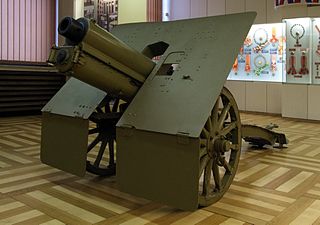
The Skoda 75 mm Model 1928 was a mountain gun manufactured by Skoda Works and exported to Yugoslavia. It was a modernized version of the Skoda 75 mm Model 15. The gun typically had a 75 mm barrel; however, it could be fitted with a 90 mm barrel. The Wehrmacht redesignated these guns as 7.5 cm GebK 28 or 7.5 cm GebK 285(j). The gun crew was protected by an armoured shield.
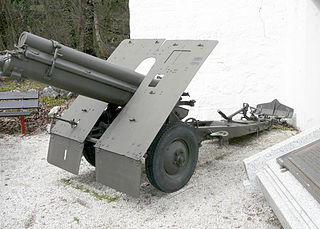
The Skoda 100 mm Model 1916 was a mountain howitzer used by Austria-Hungary during World War I. The Turks used a 105 mm variant, the M.16(T). The Wehrmacht redesignated this as the 10 cm GebH 16 or 16(ö). Guns acquired from Italy, after 1943, were known as 10 cm GebH 316(i); those acquired from Czechoslovakia were 10 cm GebH 16(t). The Italians referred to weapons gained either through capture or reparations as the Obice da 100/17 modello 16. The gun could be broken into three sections, intended for towing by two animal carts. The gun crew was protected by a gun shield. The Italians used lighter shells than the Czechs, which accounts for the greater range and muzzle velocity of their guns.
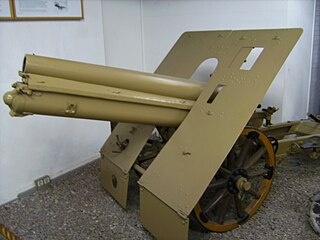
The Škoda 100 mm Model 16/19 was a mountain howitzer modified by Škoda Works from the design of the M.16, and its most notable difference was the longer barrel. It is unclear if they were newly built, or rebuilt from older howitzers. The Czechoslovak Army used this gun in both its 100 mm and 105 mm variants. After 1938, the guns were used by the Wehrmacht as 10 cm GebH 16/19(t) and 10.5 cm GebH(t). In addition, some of these guns were also used by Italy and Turkey, although this needs confirmation. The gun broke down into 3 loads for transport. The gun crew was protected by an armoured shield.

The 7.5 cm Infanteriegeschütz 37 was an infantry support gun, used by Germany during World War II. The guns were originally designated 7.5 cm PaK 37. The IG 37s were manufactured from carriages of 3.7 cm Pak 36s and a barrel designed originally for the IG 42 infantry support gun. As an anti-tank weapon it used a hollow charge shell with 0.5 kg of explosives to penetrate up to 85 mm (3.3 in) with a velocity of 395 m/s (1,300 ft/s). The first 84 guns were delivered in June 1944. By the end of the war 1,304 guns were operational.
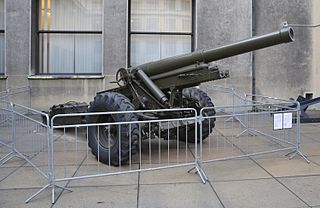
The Škoda 149 mm K series was a line of heavy howitzer designs that served with Germany, Turkey, Romania, Slovakia, and Yugoslavia during World War II.
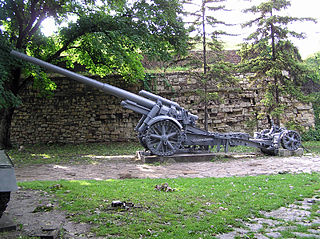
The 15 cm Kanone 18 was a German heavy gun used in the Second World War.

The 10 cm schwere Kanone 18 was a field gun used by Germany in World War II. The German army wanted a new 10.5 cm gun as well as 15 cm howitzer which were to share the same carriage. Guns are heavier than howitzers due to the longer barrel. This also led to the 15 cm sFH 18. As such both weapons had a similar weight and could be carried by a similar carriage. By 1926 Krupp and Rheinmetall had specimen designs, and prototypes were ready by 1930, but was not fielded until 1933–34. Both Krupp and Rheinmetall competed for the development contract, but the Wehrmacht compromised and selected Krupp's carriage to be mated with Rheinmetall's gun.

The 4.2 cm Pak 41 was a light anti-tank gun issued to German airborne units in World War II. This gun was externally similar to the 3.7 cm Pak 36, using a modified version of the latter's carriage, but used the squeeze bore principle to boost its velocity, and hence armour-piercing ability. The bore had a diameter of 42 mm (1.7 in) at the chamber, but tapered down to 28 mm (1.1 in) at the muzzle. Production was terminated in June 1942, after the delivery of 313 guns. By November 1943, 47 remained in service.

The 8 cm kanon vz. 30 was a Czech field gun used in World War II. Guns captured after the German invasion of Czechoslovakia in March 1939 were taken into Wehrmacht service as the 8 cm FK 30(t). It was used by a variety of German units during World War II, including I./SS-Artillerie-Abteilung 3 between 1939 and 1940.

The 4.7 cm KPÚV vz. 38 is an anti-tank gun produced by the Škoda Works that saw service in World War II. Originally designed for the Czechoslovak Army, some were also sold to Yugoslavia. A number were appropriated by the Germans after the German occupation of Czechoslovakia in 1939 and used under the names 4.7 cm PaK (t) or PaK 38(t). The Germans continued production and mounted the PaK 38(t) on the Panzerkampfwagen I chassis as the Panzerjäger I tank destroyer. A similar attempt to mount it on the chassis of captured Renault R-35 tanks was less successful.

The 8 cm Feldkanone M.5 was a field gun used by Austria-Hungary during World War I. It was a conventional design, with its most notable feature being its obsolescent autofrettaged bronze barrel, necessary because Austria-Hungary still had trouble making steel of the proper quality. Its development was quite prolonged as the Austrians took years to decide on the proper recoil system and type of breech. Even then production difficulties prevented its introduction into service until 1907.

The 15 cm Autokanone M. 15/16 was a heavy field gun used by Austria-Hungary in World War I. Guns turned over to Italy as reparations after World War I were taken into Italian service as the Cannone da 152/37. Austrian and Czech guns were taken into Wehrmacht service after the Anschluss and the occupation of Czechoslovakia as the 15.2 cm K 15/16(t). Italian guns captured after the surrender of Italy in 1943 were known by the Wehrmacht as the 15.2 cm K 410(i). Due to their unique ammunition, the Germans did not use them that much, and generally served on coast-defense duties during World War II.
The Bofors 12 cm M. 14 was a howitzer used by the Netherlands in World War II as the Lichte Houwitzer 12 cm L 14. Captured guns were given a German designation after the Battle of the Netherlands as the 12 cm leFH 373(h) although it is not certain that they were actually used by German forces.

The 15 cm schwere Feldhaubitze M 14 was a heavy howitzer which served with Austria-Hungary during World War I.
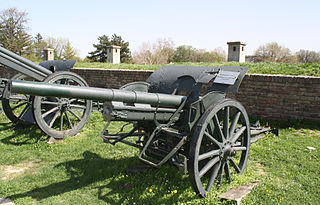
The Canon de 75 mle GPIII was a field gun used by Belgium during World War II. Cockerill mounted a sleeve in the barrels of ex-German 7.7 cm FK 16 guns received as reparations after World War I to convert them to the standard Belgian 75mm ammunition. After 1940, the Wehrmacht designated captured guns as the 7.5 cm FK 236(b). This gun was nearly the equivalent of the German 7.5 cm FK 16 nA and apparently saw wider service than the other captured Belgian guns.
The 10.5 cm cannon Model 1927 was a heavy field gun used by the Netherlands and Hungary during World War II. Dutch guns were known as 10-velds. Hungary purchased a license and built them as 31 Ms. Captured weapons were designated by the Wehrmacht as the schwere 10.5 cm Kanone 335(h). Four were bought by the Swedish Coastal Artillery as 10.5 cm kanon m/27s. They were later upgraded to m/34 standard as m/27-34s. They were transferred to the field artillery in 1942. The Dutch appear to have bought guns with both 40 and 42 caliber barrel lengths.

The 9 cm PL kanon vz. 12/20 was a Czech anti-aircraft gun used during World War II. Those weapons captured after the German occupation of Czechoslovakia in March 1939 were taken into Wehrmacht service as the 9 cm Flak M 12(t). Some guns were reportedly captured in Yugoslavia and the Soviet Union as well. Twenty were in Czech service during the Munich Crisis in September 1938. Twelve were in German service between August 1943 and June 1944. According to Nebojša Đokić and Branko Nadoveza "Import of weapons for Army and Navy of Kingdom of SHS and Yugoslavia" 1 battery were apparently stationed in Bay of Kotor in Kingdom of Yugoslavia. Same authors in second part of book "Import of weapons for Army and Navy of Kingdom of SHS and Yugoslavia" in which import from Great Britain and Germany was analyzed, claim that 9 guns were installed on 6 Galeb-class minelayer minelayers of Royal Yugoslav Navy, 2 each on Sokol, Galeb and Orao and 1 on Jastreb Kobac and Gavran. Latter some of those guns (5?)were replaced with 8.35cm Škoda AA guns. It is possible that some of those guns after replacement on ships were put in service as ground anti aircraft battery.
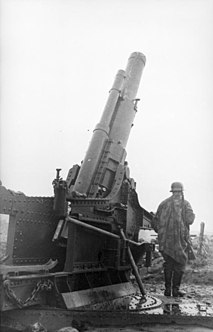
The Škoda 220 mm howitzer was a siege howitzer design which served with Germany, Poland, and Yugoslavia before and during World War II.
The 8 cm kanon vz. 28 was a Czech field gun used during World War II.
The 10 cm houfnice vz. 28 was a Czech howitzer used in limited numbers by the Yugoslav Army during World War II. The Yugoslavians ordered twenty houfnice vz. 28 guns which they referred to as the 100 mm M.28. Guns captured from Yugoslavia by the Germans were given the designation 10 cm leFH 317(j).















